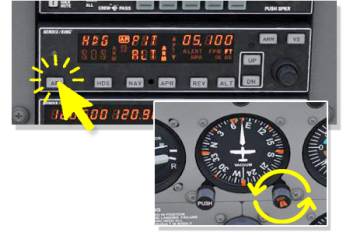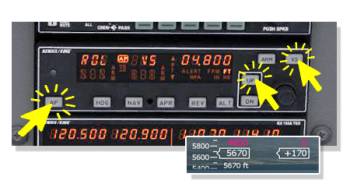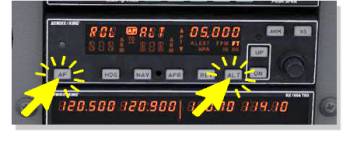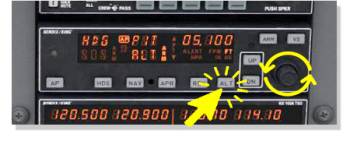Table of Contents
Basic Autopilot
The basic autopilot is found in the Cessna 172 SP and the Baron 58 aircraft. It features a bank and heading hold, turn to selected heading, navigation follow, pitch hold, vertical speed hold, altitude hold and approach modes as well an altitude pre-select function.
Engagement Conditions
The autopilot can stabilize the heading, airspeed, altitude as well as the vertical speed. The autopilot cannot be switched on/off and will disengage when one of the following limits is exceeded:
- bank angle larger than 60 degrees
- pitch angle larger than 45 degrees
- airspeed less than 1.2 times the stall speed
- when the aircraft is on the ground.
Autopilot Lateral Modes
When the autopilot is turned on it will maintain the current pitch and bank attitude. These modes are indicated with the text “ROL” and “PIT” for roll and pitch respectively.
Wings Level (ROL)
In this mode the autopilot will attempt to keep the wings level (ROL). The autopilot switches to heading hold mode once the wings are leveled to offer a long term constant flight path but this is not shown to the pilot.
- To activate this mode deselect any other active lateral mode.
- Selecting a different lateral mode disengages the roll hold.
Heading Select (HDG)
In the bottom right of the horizontal situation indicator (HSI) or heading indicator you can find the heading bug. Rotate this knob to select a target heading on the compass rose.
- To activate the heading select mode can be pressing the HDG button on the autopilot panel.
- Press the HDG button again to deactivate it.
Navigation Mode (NAV)
The autopilot can track a VOR or ILS signal. For this you need to tune a station first and then set the course and arm the capture.
- Select the frequency of a nearby VOR station with in the NAV1 panel.
- Transfer the selected standby frequency to the active with the NAV1 swap button.
- Rotate the OBS1 knob to set the desired radial.
- If you are not already flying towards the VOR radial select a heading with the heading knob, then engage the heading mode first with the HDG button to fly roughly in the right direction.
- Then arm the CDI capture by pressing the NAV button on the autopilot panel.
Once captured the autopilot will try to center the course deviation indicator (CDI) needle.
- Push the NAV button again to disarm the NAV capture or to disable the NAV mode if already engaged.
- If the mode was already engaged and you turn it off the autopilot switches back to attitude hold mode.
Autopilot Vertical Modes
Pitch Hold (PIT)
The pitch attitude hold (PIT) mode maintains the pitch angle at the time of engagement.
- The pitch hold mode is activated by turning off all other vertical modes or when the autopilot is turned on.
- You can change the selected pitch attitude with the UP/DOWN buttons on the autopilot panel.
You are still in control of your airspeed, make sure to add enough power if you want to climb and reduce power for the descent.
Vertical Speed Hold (VS)
When engaged the vertical speed mode (VS) holds the current vertical speed.
- Push the VS button to activate the vertical speed mode.
- Use the UP/DOWN buttons to change the target vertical speed.
- Push the VS button again to deactivate this mode.
You are in control of airspeed, make sure to adjust power.
Altitude Hold (ALT)
This mode maintains the altitude at the time of engagement. The autopilot will pitch up and down to try and stay at that altitude.
- Push the ALT button to engage altitude hold mode. The airplane will fly back to the altitude that you had when you pushed the button.
- Push the ALT button again to disable the altitude hold mode.
The autopilot will automatically switch to the altitude hold mode when you reach the selected altitude in pitch hold (PIT) or vertical speed hold (VS) mode.
- Rotate the large and small knobs on the autopilot panel to change the selected altitude in 1000ft and 100ft increments respectively.
- Push the ARM button to arm the altitude capture mode.
- Push the ARM button again to disarm altitude capture upon reaching the selected altitude.
Autopilot Approach Mode
The approach mode has to be armed and captured similarly to the lateral only NAV mode. The key difference is that the autopilot will also try and capture the vertical steering from the NAV1 receiver and follow the glide slope of the ILS.
- Tune an ILS using the NAV1 panel.
- Set the ILS course with the OBS1 knob.
- Turn the aircraft to an intercept heading using the HDG knob and autopilot HDG pushbutton
- Arm the approach mode by pressing the APPR button.
After capturing the localizer signal the autopilot arms the glide slope capture. Monitor the engagement of the lateral and vertical LOC and GS modes and reduce power to maintain the desired airspeed once the glide slope is activated.
- Push the APPR button again to disarm the ILS capture
- If already engaged the autopilot will revert to attitude hold mode and maintain pitch and bank.




